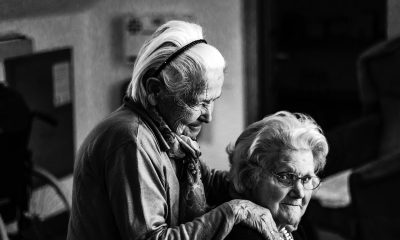Senior care systems differ widely around the world, as well as amongst the wealthiest countries. For example, senior care in the US looks quite different compared to the UK and the Scandinavian countries. In this article, we will explore what sets the US apart from other countries when it comes to how the elderly are cared for, supported, and assisted. As we shall see, the US differs in many important ways from other countries in terms of senior care programs and its health system, which affects the level of care that senior citizens can expect to receive.
Senior Care in the US Ranks Worse Compared to Other Wealthy Countries
The Commonwealth Fund’s 20th International Health Policy survey, published in 2017, compared the health experiences of senior citizens in 11 different countries. As well as the US, other nations examined included Australia, Canada, France, Germany, the Netherlands, New Zealand, Norway, Sweden, Switzerland, and the UK. In terms of various categories, such as access, affordability, timeliness of care, and care coordination, the US ranked worst or nearly the worst. This survey also included an analysis of elderly people who had the greatest medical needs, those who are severely sick and who face the most complex social challenges as a result of their poor health.
All US adults aged 65 and over qualify for Medicare. Senior citizens are the only group that enjoys universal health insurance. However, Medicare isn’t free, which is a common misconception. Danielle Roberts, the co-founder of Boomer Benefits, an insurance firm in Fort Worth, Texas, said:
“I’d say a full third of people we talk to, who are just starting to do their research, are surprised – some are appalled and flabbergasted – that they have to pay anything for Medicare.”
The cost of Medicare – which can prove to be quite expensive at times – contributes to the massive disparity we see in the care of seniors in the US compared to other countries. As a case in point, there is a wide range of health care that UK citizens can get for free as part of the National Health Service (NHS).
The Cost of Medicare
Signing up to Medicare doesn’t mean you can avoid big health care costs as a senior citizen. Fidelity Investments found that the average male-female couple will spend $285,000 on health care from the age of 65 onwards. This is certainly no small amount.
If you have a 10-year work history, then you don’t have to pay any premiums for Medicare Part A (this covers hospital stays, skilled nursing, hospice, and some home health services). The deductible of Part A is $1,364 per benefit period. Then there’s Part B, which covers outpatient care and medical supplies. This involves paying a standard monthly premium of $135.50; however, higher earners have to pay more. The deductible of Part B is $185. Medicare Part D covers prescription drugs. The average cost of this coverage is $32.50 per month, with high earners, again, paying more. The deductible of Part D is $415.

Senior citizens in the US may also find their health care costs adding up because of penalties. As a senior, if you don’t sign up to Medicare when you first qualify for coverage and want to sign up later, you could face life-lasting penalties. This would make the premiums much higher than they otherwise would have been.
If you are on a low income, then you can qualify for programs that reduce the costs of Medicare. There is also extra help available for prescription drug coverage and some state-run savings programs that can help you with copays, copremiums, deductibles, and premiums. Nonetheless, there are many aspects of health care, which are free or available at a low cost in other countries, which can cost seniors a lot in the US. For example, Medicare doesn’t cover dental, hearing care, basic vision, over-the-counter medicines, and long-term care.
On the subject of Medicare compared to health insurance in other countries, David Blumenthal, president of the Commonwealth Fund, said:
“I don’t think there’s any question that many elderly Americans pay a substantial amount out of pocket that would not be paid by people in other countries where there is no coinsurance or deductibles.”
Financial Barriers to Senior Care
In the International Health Policy survey, researchers found that, overall, one in eight seniors had three or more chronic health conditions, while in the US, one in three (36%) had multiple chronic conditions. What is surprising, however, is that 23% of US respondents said they did not go to a doctor when they were ill, nor did they get a medical test, procedure, or prescription when they needed it. The reason they cited was the high cost of treatment. This kind of problem is much less significant in other wealthy countries. For instance, in France, Norway, Sweden, and the UK, 5% (or fewer) older people said they avoided medical treatment due to financial concerns. Robin Osborn, the lead author of the Commonwealth Fund’s report, noted:
“What stands out is that U.S. older adults are sicker and more economically vulnerable, despite having Medicare, our version of universal coverage. U.S. seniors struggle to afford care and face more financial barriers to care than in the 10 other countries.”
The financial cost of Medicare also means that many US seniors struggle with their other finances. 25% of older adults in the US reported that they were worried about having enough money for food, rent, utility bills, or when it came to paying for medical care. This contrasts with senior citizens in France, Norway, Sweden, and the UK, with fewer than 5% of respondents saying they struggled with their finances as a result of health care costs. Due to concerns about making sure other finances are in order, it seems that many older people in the US will avoid medical treatment. Which, of course, will lead to a decreased quality of life and well-being.
We see a similar, worrying trend when it comes to “high need” older adults. This refers to senior citizens with three or more chronic conditions and who struggle to carry out their daily activities, such as getting around, personal hygiene, getting dressed, and so on. The survey revealed that, among this group of seniors, a third (31%) avoided health care because of costs, compared with only 2% of older people in Sweden. All residents in Sweden have access to publicly-funded health care. While health care is universal, widely available, and funded by taxes, there are small fees associated with some health services. This still, nonetheless, makes health care and medical treatment affordable for nearly all older adults in Sweden.

In the US, the fact that high need older adults avoid treatment is problematic. This is because these types of seniors are more likely to:
- Be economically vulnerable
- Experience depression and anxiety
- Be at greater risks of falls
- Live alone and experience isolation
Due to the way the health care system is set up, many seniors in the US don’t get treatment when they need it, whereas this is much less of an issue in other wealthy countries.
It will be useful now to compare how the US differs from other countries when it comes to the specifics of senior care. As we shall see, some elderly care systems are more reliant on the state than others. Countries also vary in the prevalence of care homes, assisted living, and other forms of senior programs and support for the elderly.
Seniors Prefer to Stay at Home in the US
The American Association of Retired Persons (AARP) published a survey showing that nearly 90% of older adults said that they want to live in their own home. Medicare can still support seniors living at home, nonetheless, through nursing home care, as well as home help, such as cooking and washing support. Only 4% of seniors would want to move into a relative’s home instead of staying in their own place.
In spite of these figures, many families do take on some costs when it comes to caring for older parents. This cost is between $7,000 and $14,000 per year. Some seniors choose to live in a nursing home, usually funded by a private healthcare plan. In 2014, 11.2% of women aged 85 and over lived in a nursing home, compared to 6.1% of men in the same age bracket.
The Elderly Care System in the UK
In the UK, assisted living (also known as extra-care housing) is quite common. This provides older adults with housing that is specifically designed for elderly people who need more support than others. They often feature community rooms, which gives residents a space to socialize with each other. A warden may also be present during the day. Such homes are designed with safety and ease of living in mind. Usually, bathrooms will be fitted with grab rails, toilet aids, shower seats, and non-slip floors.

Assisted living tends to be a senior person’s first introduction into the elderly care system in the UK. The next step might be residential care or nursing homes. These provide round-the-clock care. These services are not free, although some older adults can get assistance in funding their stay if they need to.
Elderly care systems differ depending on the region of the UK. For example, in Northern Ireland, home care – which involves help with everyday tasks – is free for those aged 75 and over. Meanwhile, this kind of care is free in Scotland for those aged 65 and above, if they are assessed as needing help with tasks like getting dressed, washing, and preparing meals.
How Senior Care is Changing in Canada
Canada has a universal health care system. As a Canadian citizen, you qualify for public health insurance. Once you have that, you don’t have to pay for most health care services. The system is funded through public taxes.
The elderly care system in Canada is reliant on nurses to provide care for older adults. Unfortunately, the demand for nursing services for seniors is expected to rise at a faster rate than the supply of nurses who care for seniors. Health care services for seniors in Canada are stretched. This is why more Canadians are taking on the role of caregiver and looking after their parents as they age. More than 30% of Canadians with older parents spend around 450 hours a year taking time off work so that they can provide their parents with the care they need.
Senior Care in Belgium
Elderly people in Belgium can receive most of the care they need from the public system of health care, funded by social contributions and taxes. Family members will also offer a large amount of informal care to their older family members. In Belgium, the trend is to ensure that older adults can stay in their own homes for as long as possible. Seniors who have their own space can also get some extra assistance if they need. This includes home help, such as help with cleaning, washing, doing the dishes, and daily chores, like shopping and preparing meals. When families find that their time is stretched, day care and short stay centers are available and often prove helpful.

‘Kangaroo housing’ is another way that Belgium’s elderly can find the support they require. This initiative, which started 30 years ago, involves older adults living with immigrant families in the same house but on separate floors. The immigrant family will offer help to the older person should they ever need it. The initiative was launched in the Belgian district of Molenbeek, where 25% of people are retired and 65% are immigrants. Many believe that kangaroo housing has helped to reduce the isolation that many retired people feel, as well as improve the overall well-being of older people.
Older Adults in Germany Prefer to Avoid Nursing Homes
One survey found that 82% of Germans do not want to grow old in a nursing home. A particular scheme that prevents this sort of scenario is cohabitation. In 2013, the introduction of grants allowed elderly people to live in community apartments with other older adults. This allows seniors in Germany to cohabit and socialize when they feel the need to, which is an important way of reducing the problem of isolation and loneliness, and the mental health issues that arise from it, such as depression.
Germany has faced a similar problem to Canada, with a shortage of medical staff for its aging population. In response, a training scheme called BeQuFa has been helping people from Germany’s large refugee population become carers for elderly people. This allows refugees to find employment and integrate into Germany society, and it ensures that older adults aren’t left without the support and care they need.
In Italy, Senior Care is the Responsibility of the Family
The elderly care system in Italy is quite different from the US and to the other countries just discussed. The percentage of adults aged 65 and over in Italy using home care services is just 1%. Which is extremely low. In the UK, the figure is 5.5%, in Germany, it’s 6.5%, and in Scandinavia, it’s 10%. Institutions in Italy will tend to only intervene and provide support for older adults if they have no family around to care for them. Caring for the elderly in Italy is widely believed to be the responsibility of the family.
The health care system in Italy is a national health service known as Servizio Sanitario Nazionale (SSN) and is similar to the UK’s NHS. It provides universal health care, with most health services being free of charge. Elderly people in Italy can get the following treatments for free and by making a small co-payment: tests, medications, surgeries during hospitalization, doctor visits, out-patient treatments, and dental work.

As we can see, there are many differences between the senior care system in the US and that of other countries. The US’ privatized healthcare system means that senior care is often much more expensive for older American adults than it is for seniors in other countries, especially when compared to countries that have publicly funded health care. Moreover, certain cultural differences mean that families caring for older parents is more common in some countries than others. The rising elderly population, coupled with a shortage of staff to care for the elderly, means that family-oriented care is also becoming increasingly common in certain countries. As the elderly population continues to increase (due to extended life expectancy), countries all over the world will need to find the resources and solutions that will ensure older adults can maintain their well-being in the later stages of their life.






